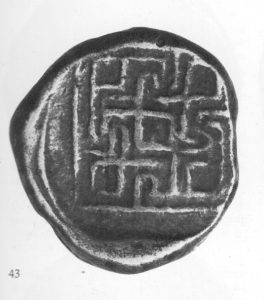In Greek mythology, the labyrinth is the place where the Minotaur is hidden and imprisoned. It is therefore not necessarily a real place.
The labyrinth, as we know it today, is highly inappropriate. Because it has an entrance, a clear path and an accessible center.
Thus, on the silver coins from Knossos we also find very different interpretations of the labyrinth. There are meanders and other symbolic representations.
I want to pick out a motif today and take a closer look at it.
I found two examples with the same motif. One on a coin from the Coin Cabinet of Berlin:
And one on a coin from the British Museum in London:
They both represent the same thing. Although the “Berlin” coin seems to be more exact, it contains small errors in two places in the upper area. Two vertical lines collide, where a gap should actually be. This area is more accurately represented on the “London” coin, although the lines there are harder to see.
I made a “final drawing” that shows what the coin maker wanted to show. You can see lines that follow a certain pattern. They are symmetrical, repeating themselves and showing an intricate “path system”. The drawn red thread shows that.
There are four nested paths without beginning and end, but also without entrance. This is not “our” labyrinth but better suited as a prison. The Minotaur would not come out that fast.
This could be a hint of the Roman sector labyrinth hundreds of years later.
But it also shows a certain relationship to the Babylonian labyrinth, hundreds of years older and developed in a different culture (see the labyrinthine finger exercises in the post about the Babylonian labyrinth).
Related Posts
- The Labyrinth on the Silver Coins of Knossos, Part 1
- The Labyrinth of the Minotaur
- The Babylonian Labyrinth
Further Link





Pingback: The Labyrinth on the Silver Coins of Knossos, Part 3 | blogmymaze
Pingback: A Golden Greek 50 Euro Commemorative Coin from 2017 | blogmymaze
This is so wonderfully detailed and helpful Erwin, you never fail to inform or inspire.
LikeLiked by 1 person
I really enjoy your posts, Erwin!
LikeLiked by 1 person